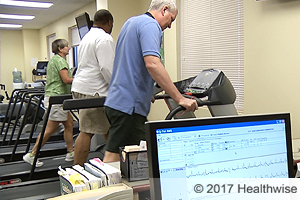Cardiac Rehabilitation: Exercise
Topic Overview

Exercise is an important part of a cardiac rehabilitation program. Combining exercise with other lifestyle changes, such as eating a balanced diet and stopping smoking, reduces the risk of future heart problems.
What kinds of exercise will you do?
Riding a stationary bike, walking on a treadmill, and resistance training (working with weights) are types of exercise you may do during cardiac rehabilitation (rehab).
You will likely do aerobic exercise, strength training, and flexibility exercises. During recovery and then rehab, your exercise program will be specifically designed for you. It might progress from a supervised program monitored by an exercise physiologist or other qualified professional to an independent, self-managed program.
You will be taught to check how hard you are working when you exercise. You will be taught to check your heart rate or your exercise level known as a rating of perceived exertion (RPE). It is important to keep your heart rate from getting too high. Your doctor will tell you how fast your heart rate should be with exercise. Self-monitoring is often used during the last stage of a rehab program, when you continue your cardiac rehab on your own without close supervision.
What are the benefits?
Everyone can benefit from exercise. But if you have some type of heart problem, the benefits of exercise will be even greater than for most people. Cardiac rehab programs are designed to restore and help you keep your physical function. Whether your goal is to return to work as soon as possible, live a more active lifestyle, or achieve a level of independence to increase the quality of your life, exercise must be a regular part of your routine.
You can benefit from exercise whether you exercise at a high intensity for just a short time or at a low intensity for a longer period of time. If, for example, you are a person who finds exercising difficult, you still can obtain the benefits of regular exercise simply by walking.
Cardiac rehab exercises can:
- Lower your risk of dying of heart disease.
- Lower your blood pressure.
- Improve your cholesterol levels.
- Help you control your diabetes.
- Make your angina symptoms less severe and happen less often.
- Reduce your symptoms of heart failure.
- Help you lose weight or stay at a healthy weight.
Exercise can also improve your quality of life, endurance, and muscle strength. After a few months of exercise in a cardiac rehab program, you can increase your ability to exercise. Your daily activities (such as carrying groceries) will be easier to do. You may also have an improved sense of wellness, because exercise can help alleviate depression, stress, and anxiety.
Benefits of aerobic exercise for your heart
Your heart is a muscle with fibers that allow it to contract and pump blood. Like other muscles in your body, your heart will respond to exercise. When a muscle is used during exercise, the fibers inside it become stronger and more efficient. Increasing your heart rate during aerobic exercise not only strengthens the heart itself but also helps more blood circulate through your body. Blood contains oxygen and nutrients that increase the health and efficiency of many of your body’s important systems.
Other benefits of aerobic exercise
There are many other physical and mental benefits of aerobic exercise for cardiac rehab.
- Physical benefits:
- Increases aerobic ability (the ability of your body to use oxygen)
- Increases lung volume and the lungs’ ability to take in oxygen
- Reduces the demands on your heart both at rest and during exercise
- Lowers blood pressure
- Can reduce your proportion of body fat
- Mental benefits:
- Reduces anxiety
- Helps improve mild to moderate depression
- Helps improve mood, self-esteem, and self-concept
What about functional benefits?
Exercise also has specific benefits for your body’s functions, including increased:
- Size and strength of your muscles.
- Efficiency of your muscles to use nutrients and oxygen.
- Ability of your lungs to provide oxygen to your bloodstream.
- Ability of your body to transport oxygen to the working muscles and organs.
- Strength and efficiency of the heart (increases the amount of blood pumped per beat).
Benefits of strength training
Strength training has many benefits for you during your recovery and rehabilitation.
- When you have more muscle, your body burns energy faster. This faster energy burn can help you manage your weight.
- Strength training can decrease the demands on your heart when you do daily activities such as lifting.
- Strength training can help improve your stability and reduce your chance of falling.
- Strength training can help increase your bone density and make your bones stronger, especially if you are older.
Credits
Current as ofApril 9, 2019
Author: Healthwise Staff
Medical Review: Rakesh K. Pai MD, FACC – Cardiology, Electrophysiology
Martin J. Gabica MD – Family Medicine
E. Gregory Thompson MD – Internal Medicine
Adam Husney MD – Family Medicine
Richard D. Zorowitz MD – Physical Medicine and Rehabilitation
Current as of: April 9, 2019
Author: Healthwise Staff
Medical Review:Rakesh K. Pai MD, FACC – Cardiology, Electrophysiology & Martin J. Gabica MD – Family Medicine & E. Gregory Thompson MD – Internal Medicine & Adam Husney MD – Family Medicine & Richard D. Zorowitz MD – Physical Medicine and Rehabilitation
Topic Contents
This information does not replace the advice of a doctor. Healthwise, Incorporated, disclaims any warranty or liability for your use of this information. Your use of this information means that you agree to the Terms of Use. Learn how we develop our content.

